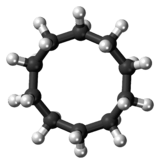Cyclodecane
 | |
 | |
| Names | |
|---|---|
| IUPAC name
cyclodecane | |
| Identifiers | |
3D model (JSmol) |
|
| ChemSpider | |
| ECHA InfoCard | 100.005.485 |
PubChem CID |
|
| |
| |
| Properties | |
| C10H20 | |
| Molar mass | 140.27 g/mol |
| Appearance | colorless liquid |
| Density | 0.871 g/cm3 |
| Melting point | 9 to 10 °C (48 to 50 °F; 282 to 283 K) |
| Boiling point | 201 °C (394 °F; 474 K) |
| Hazards | |
| Flash point | 65 °C (149 °F; 338 K) |
Except where otherwise noted, data are given for materials in their standard state (at 25 °C [77 °F], 100 kPa). | |
| Infobox references | |
Cyclodecane is a cycloalkane with the chemical formula C10H20.
Low-temperature 13C NMR spectra of cyclodecane (1) showed the presence of a minor conformation, assigned to the twist-boat-chair-chair (TBCC), in addition to the expected boat-chair-boat (BCB). If only the TBCC and BCB conformations were assumed to be appreciably populated, then a free-energy difference between the two conformations of 0.73 ± 0.3 kcal/mol could be obtained from the five area measurements over a temperature range of −148.6 to −131.0 °C, with populations of 5.2 and 94.8% for the TBCC and BCB conformations at −146.1 °C. However, an alternative description of the conformations of 1 was suggested by the ab initio calculations, which predicted that the twist-boat-chair (TBC) and TBCC conformations have comparable free energies and populations. Equal amounts of TBCC and TBC would give populations of 5.2, 5.2, and 89.6% and relative free energies of 0.72, 0.72, and 0.00 kcal/mol for the TBCC, TBC, and BCB conformations at −146.1 °C, based on the experimental areas at this temperature. The experimental spectra could neither confirm nor disprove the presence of the TBC. Saunders' calculations of the strain energies of 1 using Allinger's MM3 program were reproduced to obtain a complete set of these parameters and drawings of the conformations, and free energies and populations were obtained at +25 and −171.1 °C. Free energies were also calculated at the HF/6-31G* and HF/6-311G* levels, and chemical shifts were obtained for three conformations at the HF/6-311G* level by the GIAO method. Chlorocyclodecane (2) was shown by 13C and 1H NMR spectroscopy to have three conformations at −165.5 °C. To aid in conformational assignments, the 13C chemical shifts were calculated for all of the BCB and TBCC conformations of 2 using the GIAO method at the HF/6-311G* level. The free energies for each of the possible BCB, TBCC, and TBC conformations were also calculated using Allinger's MM3 program. From the line shape changes in the experimental 13C NMR spectra, the free-energy barriers, a consideration of the X-ray structures of substituted cyclodecanes, and these calculated chemical shifts and free energies, the three conformations of 2 at −165.5 °C were suggested to be 2e BCB (31.2%), 2a BCB (14.9%), and a TBCC conformation (53.9%) (numbering as in Figure 1); the 2e and 2a BCB assignments could be reversed. Free-energy barriers for interconversion of BCB conformations of 2 at −159.8 °C were 5.4 ± 0.2 and 5.5 ± 0.2 kcal/mol, and the free-energy barriers at −120.9 °C for equilibration of the TBCC conformation with the rapidly interconverting BCB conformations were 7.07 ± 0.2 and 7.08 ± 0.2 kcal/mol. The 13C NMR spectrum of cyclodecyl acetate (3) at −160.0 °C showed a similar pattern of chemical shifts and intensities for the substituted ring carbon.
References
External links
- Diwakar M. Pawar; Sumona V. Smith; Hugh L. Mark; Rhonda M. Odom,; Eric A. Noe (1998). "Conformational Study of Cyclodecane and Substituted Cyclodecanes by Dynamic NMR Spectroscopy and Computational Methods". Journal of the American Chemical Society. 120 (41): 10715. doi:10.1021/ja973116c.